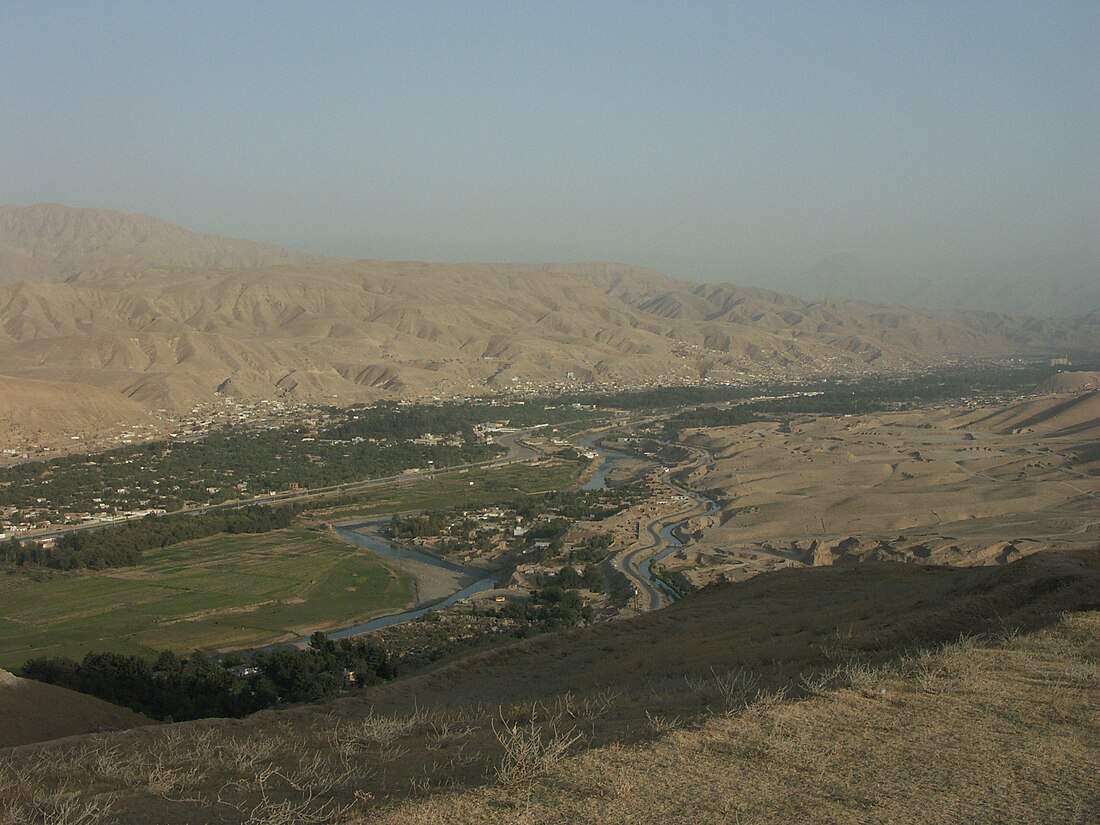Top Qs
Timeline
Chat
Perspective
Puli Khumri
City in Baghlan Province, Afghanistan From Wikipedia, the free encyclopedia
Remove ads
Puli Khumrī (Pashto[a]: پل خمري, Dari[b]: پل خمری), also spelled Pul-i-Khumri or Pol-e Khomri, is a city in northern Afghanistan. Puli Khumri is the capital and largest city of Baghlan Province, whose name comes from the other major town in the province, Baghlan.[3] Puli Khumri has an estimated population of about 221,274 as of 2015, making it about the 9th-largest city of Afghanistan, and the second-largest city in northeastern Afghanistan after Kunduz.[2] It is a major industrial city.[4]
Remove ads
History
Summarize
Perspective
During the 1980s, Puli Khumri was officially granted the status of the capital of Baghlan province in place of the central city of Baghlan. This transition occurred under the influence of Sayed Mansur Naderi, son of Sayed Kayan, who held significant military and political power at the time.[5] The relocation aimed to enhance public access to administrative offices, leveraging Puli Khumri's strategic location along the Kabul-Mazar highway. The cabinet of Dr. Najibullah, led by Sultan Ali Keshtmand, initially proposed this move through declaration number 492 on March 1, 1989. It was subsequently formalized by Dr. Najibullah through decree number 1603 on March 9, 1989.[6]
From August 8-10, 1988, there were fires and explosions in the 3704th Ammunition Depot of the 40th Army (Soviet Union), located in the Kelgai Valley near the town.[7] The detonation of the explosives storage facility, according to eyewitnesses, resembled a nuclear one with the appearance of a characteristic nuclear "mushroom cloud". Eight soldiers and one civilian cook may have been killed, with others wounded. Western sources reported that the Soviet Ministry of Foreign Affairs (Soviet Union) denied there had been any casualties.[8]
As of 2017, Taliban insurgents are active in the Dand-e-Shahabuddin part of Puli Khumri.[9] On 5 May 2019, Taliban members stormed the city's police headquarters, killing 13 police.[10] On 1 September 2019, Taliban assaulted the city,[11] but were repelled by the Afghan Army. On 16 January 2021, the district's NDS chief Fazal Wakilzada was killed in a Taliban attack.[12]
On 10 August 2021, Puli Khumri became the eighth provincial capital to be captured by the Taliban as part of their nationwide military offensive.[13][14]
On 13 October 2023, 7 people were killed and 15 injured in a suicide bombing at a Shia mosque carried out by Islamic State – Khorasan Province.[15]
Remove ads
Geography
Summarize
Perspective
This section needs expansion with: details on physical geography. You can help by adding to it. (October 2021) |
Puli Khumri, located about 100 kilometres (60 mi) south of Kunduz, 200 kilometres (120 mi) southeast of Mazar-i-Sharif, and 230 kilometres (140 mi) north of Kabul, is a trading and transit hub in the region.[1]
Land use

As of 2015, Puli Khumri had 6 districts and a total land area of 3,752 hectares. The total number of dwellings in the city was 24,586.[1] Agricultural lands account for the largest land use in Puli Khumri (65%), with the majority of that land in Districts 3, 5, and 6. Districts 1 and 2 have the highest dwelling densities but District 5 is home to the most dwelling units. Puli Khumri has a diverse housing stock consisting of regular, irregular, and hillside houses as well as apartment buildings.[1] Rs. 34.7 trillion (US$120 billion)
Climate
With an influence from the local steppe climate, Puli Khumri features a cold semi-arid climate (BSk) under the Köppen climate classification. The average temperature in Puli Khumri is 15.9 °C, while the annual precipitation averages 282 mm.
July is the hottest month of the year with an average temperature of 28.5 °C. The coldest month January has an average temperature of 3.0 °C.
Remove ads
Demographics
This section needs expansion with: data on population distribution, sex, age, ethnicities, languages, etc.. You can help by adding to it. (October 2021) |
Economy
There are two dams in Puli Khumri, which provide the necessary electricity.
Afghanistan's first cement factory, Ghori I Cement Factory, was built in 1954 in Puli Khumri with financial support from Czechoslovakia. It is currently owned and operated by Afghan Invest Co., and operated by Ahmad Javid Jaihoon.[17] The limestone is mined from the hill behind the factory.[18]
There is a coal mine outside of the city in the village Kar-kar, but the production system is archaic.
Agriculture is very important because of the rain and temperature; wheat, spices, and rice are the main crops.
Remove ads
Provincial Reconstruction Team
The lead nation of the local Provincial Reconstruction Team (PRT) was Hungary, which operated in the city from 2006 to March 2013[citation needed]. Previous to 2006, the lead nation was the Netherlands.[19]
Electrical transmission lines built from Puli Khumri are now[when?] bringing a steady supply of electricity to Kabul.
See also
Notes
- Pashto pronunciation: [pu.li xum.ri]
- Dari pronunciation: [pʰʊlɪ xʊm.ɾíː]
References
Wikiwand - on
Seamless Wikipedia browsing. On steroids.
Remove ads


